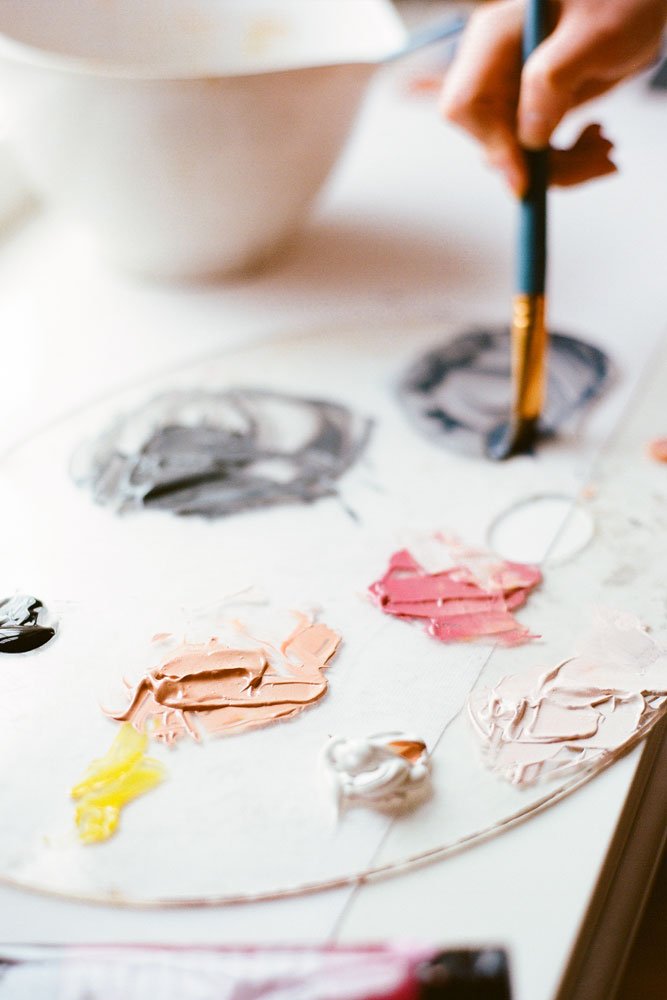I’m continuing in my Instagram series about answering the questions you’ve sent me. One user asked me, “How do you run a business as an artist?”
Whoa… where to begin? Hang on a sec as I put my hair into a ponytail and crack my knuckles (yes I crack my knuckles and yes I am aware it is a disgusting habit, just can’t quit). This is a huge question mainly because there are so many ways to be a professional artist. I can’t tell you or anyone else how to run a business as an artist because that choice remains in your hands. I can tell you the ways in which I make money and where I focus my efforts, and I can also tell you, where I don’t focus my efforts. In this post I’ll be focusing on representation. In the coming weeks I will discuss how I spend my time, and my money as a self-represented artist.
I am a self-represented artist. That means that I make, market, and sell all of my own works and products. I’m not under any exclusive contracts that mandate where or when I can sell my works. Some galleries and art consultants require exclusive contracts, I don’t work with them.
Many people argue that no artist should be self-represented because that means the artist has to run a business when they should be focusing on their art. That is true, I spend a lot more time on running my business than on painting, however it is also very important to me that I control the access to my art. I want to make all of the marketing decisions. I want to make decisions of inclusion; I do not want to leave choices like that to gallery directors or art consultants 100% of the time.
That is not to say I don’t ever work with galleries or art consultants. I have in the past, I plan on it in the future, but I’m pretty picky about the ones I want to submit to. Here’s why I’m picky. First of all, most galleries charge astronomical fees to exhibit, whether that be for wall space, time on the wall, or just taking a huge commission off of each piece you sell.
In some galleries, after all my painting expenses, time, transportation, and the gallery fees I would earn only 25% of the listed price of a painting. So if I sell a $1000 painting, I’m only earning $250. It suddenly makes a $1000 painting seem like small potatoes. Not every gallery works this way, but it is pretty common.
I only work with galleries that are artist friendly, transparent, and with whom I can agree on their vision and mission. Another thing is that I simply do not fit with a lot of galleries. I think every artist should look long and hard at the history of a gallery and study it’s past exhibitions to see if they are even a good fit. Some artists will submit anywhere and everywhere, and I think that’s a waste of my time and money.
Being self-represented I keep more of the margins of my sales because I don’t have to split them with a gallery or consultant. I can mass produce prints and home goods and market different priced products to different socio-economic classes to 1. Make sure more people have beauty and life in their lives, and 2. To expand my sales ability to different markets. I can also control the marketing of my work, I can hone in on my more ideal clients based on different marketing tactics that work well over long periods of time.
When given a commission from a third party like an art consultant, they might not always be an ideal client. If an art consultant brings me a client who picked my painting out of a book they know nothing about me, my mission or vision behind my work. I enjoy bringing in my own clients because usually they have been following me for a while before they decide to purchase, they know me, my vision and prayer to bring beauty into their life, and they are almost always more ideal clients than someone sent to me out of the blue.
That’s just a little bit about running an art business on self-representation. In no way do I look down on gallery representation or art consultants. In fact it’s always a point of pride and honor to be featured in a gallery! I 100% support gallery representation. I’m just saying that for myself, and as a way to support myself as an artist, it’s not always the most feasible method for me to earn a living. But I do end up submitting to probably 5 gallery shows a year as a way to meet people in the community, support other artists and galleries, and because, for me, gallery shows and art consultants are fun as long as it’s not an exclusive relationship!
Next week I’m discussing where I spend my time, the following week is where I spend my money as an art business. Like or share this article with your friend who is an artist, submit any questions to me below, or at my email [email protected]
Header image by Klaire Dixius Photography



Comments
Great artical!
Thank you for going over this subject!
Thanks Derek! Glad it was helpful!
Pingback: How to Spend Your Time as an Artist | Scheduling with Christine Olmstead
Pingback: How to Artist Part 3: Business Expenses - Christine Olmstead
Pingback: Welcome Visitors! | Joan A Brown Fine Arts & Services
Pingback: More ABOUT Joan | Joan A Brown